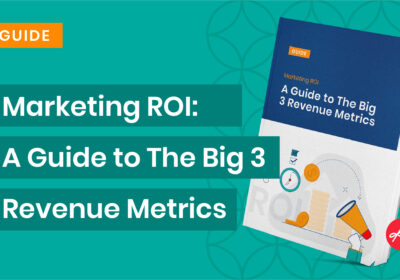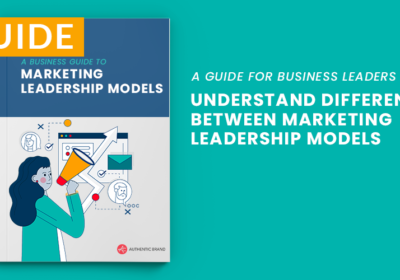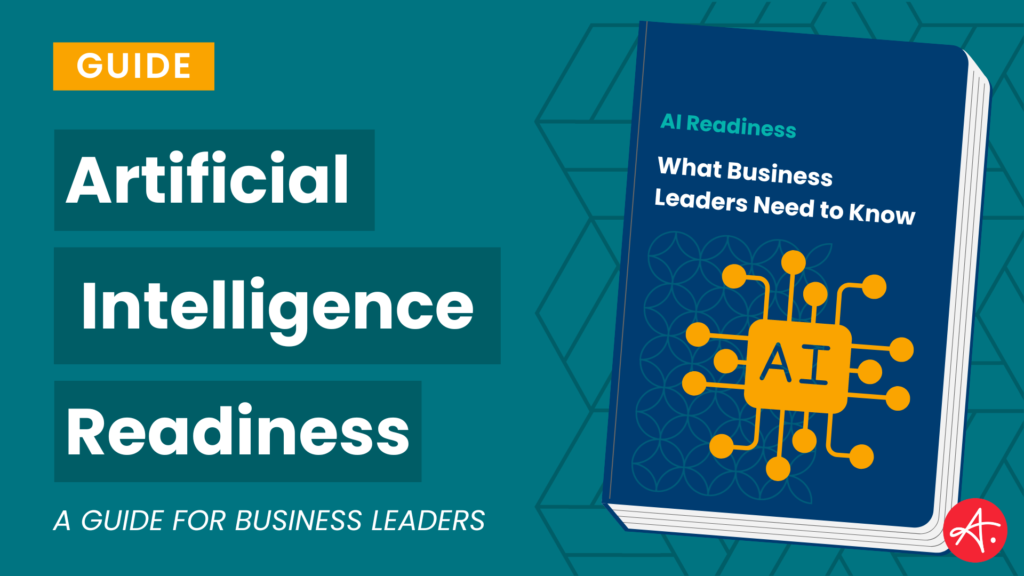
Artificial Intelligence (AI) is here to stay, and is already changing the business landscape. Leaders must be prepared to address how and where AI and machine learning can – and more importantly, should – transform essential business processes, roles, and experiences.
This guide aims to equip business leaders with practical steps they can take to become AI-ready and how to implement this technology into their organizations effectively and strategically.
Chapter One: 6 steps your business should take toward AI readiness
Prepare for a speed check
Where is your business with artificial intelligence (AI) readiness today? If you believe every AI headline you read, you may be tempted to believe that your business is already way behind in the race for innovation. But before you hit the gas and start green-lighting AI across your organization, we suggest you yield to some common sense and long-standing business best practices.
Let’s start with one important question: Which of the following is critical to effectively using AI tech to build your business and accelerate your revenues and profits?
- Assessing the commercial readiness of the technologies to be deployed and supported
- Identifying how AI technology can add value to your business
- Understanding how well AI technology will be accepted by customers and employees
- Evaluating your internal business readiness to deploy and support AI tech
- Developing a plan with goals, milestones, investments and returns, and key success metrics
- All of the above
Not much of a trick question, is it? Give yourself a gold star if you think the answer is F. But please note what is NOT on the list: Jumping into AI without a business case.
The first rule of AI readiness
AI technology is NOT a business strategy. It’s not even a technology strategy.
You might be surprised by that. But “random acts of AI” are a good way to throw precious marketing and technology funding down a black hole, to under-deliver against what your stakeholders want, and to under-perform against your investment and growth expectations.
The second rule of AI readiness
Commercial AI technology readiness is NOT the same as your business readiness to deploy AI.
AI technologies have developed to the point where they have massive market visibility and are on their way to becoming technologically mature and secure. Are they ready to use out-of-the-box today? If you believe the hype of major technology vendors like Google and Microsoft, both of whom are pushing AI success, you are already late to the party if you haven’t started.
In fact, most businesses are adopting some form of AI innovation:
“AI is already playing a role in many businesses and AI adoption is growing. In a recent IDC study, 71% of surveyed respondents said that their companies were already using AI. And, according to IDC’s Worldwide Artificial Intelligence Systems Spending Guide (August 2023), enterprise spending on AI solutions is expected to grow to $423 billion at a compound annual growth rate (CAGR) of 26.9% for 2022–2027.”
Microsoft White Paper “AI Use Cases for Business Leaders” (2024)
Meanwhile, there are 33.3 million small businesses in the United States, according to the U.S. Small Business Administration. Do you think 71% of the businesses in your market are rushing ahead with a sophisticated AI plan? Not likely. In the midst of the shiny-object frenzy and “everyone’s doing it” pressure, business leaders can be tempted to run toward AI, when it may be wiser to walk.
Cautionary tales abound
You may have read articles on Google’s Gemini chatbot. As recently as February of 2024 the chatbot was generating historically inaccurate images of white historical figures as people of color. The old technology adage of “garbage in, garbage out” is extremely significant to AI, especially if the content belongs to someone else.
States and characteristics of business and Artificial Intelligence readiness
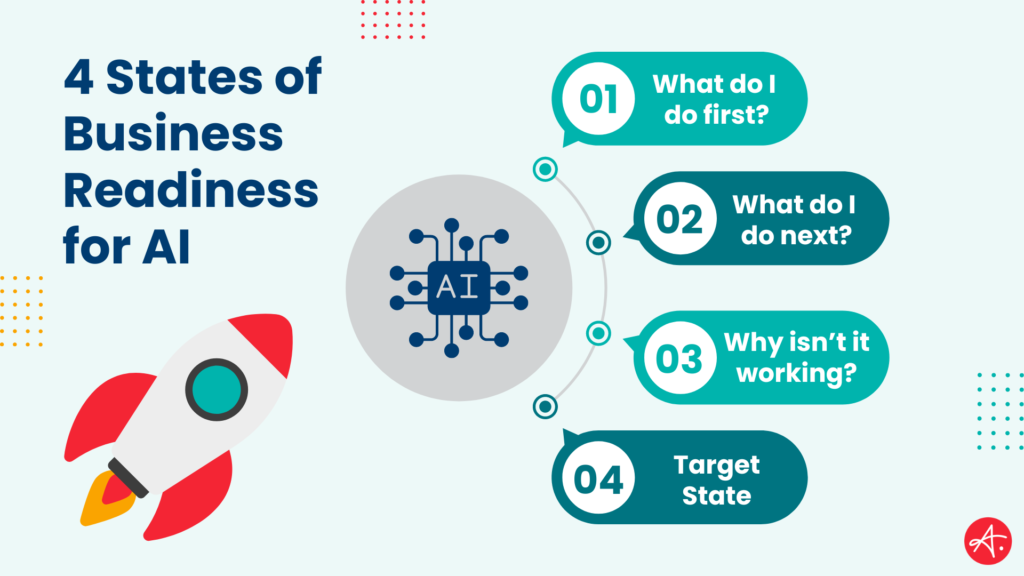
The readiness of individual businesses to understand their key opportunity areas and to tie AI deployment to growth in the form of new channels, new customers, and new offerings varies widely.
This chart should help illustrate my point:
The “What Do I Do First?” State
Low technology readiness & low business readiness
- Weak internal knowledge of AI technologies
- No AI use cases or strategy or plan
- Limited understanding of how AI can accelerate business
The “What Do I Do Next?” State
Low technology readiness but high business readiness
- Strong desire to access AI-supported opportunities
- May be willing to innovate “AI-supported” business strategy
- AI technology roadmap under-developed
The “Why Isn’t It Working?” State
High technology readiness but low business readiness
- AI tech without strategy or plan
- Impact of AI unknown, no use cases
- Poor customer reception to AI-enabled business processes
- No roadmap, milestones, or investment metrics
The “Target” State
High technology readiness & high business readiness
- AI strategy & plan aligned with business strategy & needs
- Strong insight into customer & partner needs & opportunities
- Roadmap & benefits defined
- Milestones, investment metrics identified & measured
If the key to successful AI deployment is about business readiness, then your goal should be to move your organization to the Target State.
6 steps your business should take toward AI readiness

Unless you are legitimately running an AI pilot, or have found a financially viable business case, here’s how we would recommend you start exploring AI readiness in your organization:
- Get your hands dirty playing with AI technology. Just as early Apple Macintosh users used all the fonts available when the Mac first came out and created business documents which looked like ransom notes, try out the technology on something that doesn’t matter, and which won’t destroy your business’ reputation.
- Read everything on AI that you have time for and pay attention to honest case studies which you can learn from. Remember, you can learn as much from AI implementation failures as you can from successes.
- Start talking to your customers about business processes which you, and they, think can be improved if they were automated with AI solutions. You might be surprised at what they value.
- Start capturing your own business content so you will not have to rely on third party content.
- Increase your competitive analysis so you can measure the progress of your competitors. You may also be able to learn from their AI initiatives.
- Finally, spend your time developing a plan and a fund to invest in AI. And remember that your operating costs are going to have a significant people cost as you implement and support AI solutions. You may not even have the right talent onboard to do that effectively.
How do you know your level of business readiness and where you are on this model? Just as we advise avoiding “random acts of marketing”, we also advise avoiding random acts of technology adoption.
Chapter Two: 3 major challenges in becoming AI-ready
Let’s talk about the initial gates you’ll need to move from AI ready to a successful AI deployment. There are three major challenges relating to readying organizations for successful AI tool adoption.

Challenge # 1: Information Inequality
Your first challenge is to cut through the noise to understand the current state of AI tools. AI is getting massive market visibility, thanks to major spending by tech giants (like Google and Microsoft). AI is certainly the hot story of the day, but that doesn’t mean that everyone has AI literacy.
This is a challenge we call “information inequality.” Technology vendors have thousands of people who are knowledgeable on technology in general and especially their products, and they are investing hundreds of millions of dollars selling and promoting AI tools.
What you may know about AI is a small fraction of the knowledge that they have. They sell every day, and you purchase innovative technology only once in a while. They are bombarding business executives with claims like “you are already behind the curve if you haven’t started adopting AI.”
As a challenge to that claim: Have you read about any AI failures? There are many, and while they often do not get the visibility they deserve, if you search for “AI fails,” you’ll find plenty of cautionary tales, such as these documented by CIO and Tech.co.
Learning happens from understanding both what has worked and what has not. That’s why many large corporations take a “fast follower” position regarding innovative technology. They closely watch early adopter competitors go first, then avoid their mistakes and replicate the things which worked well. This approach is excellent at risk management and maximizes investment returns.
Challenge #2: Business Plan
This may surprise you. Perhaps you were thinking that you only needed a focus on AI technology. But your responsibility as a business executive is to identify and prioritize those areas of your business where you think process-driven operational improvements are needed. Then you can take on the question of whether or not an AI solution will help drive those benefits. This is a “business first” approach which will challenge the promotion of tech vendors who focus on technology first.
Here’s an example of a business first approach: AI use in call centers is a common application of AI technology. Improving the working knowledge of your support staff and even reducing the number of your support staff are both desirable goals. But are they your top needs? Reengineering business processes often creates immediate benefit without significant investment. Call center and case management technologies can make your staff more productive with more proven technologies than AI. You might be able to achieve your near-term goals without AI.
You may also want to ask your customers what areas of your business they would like to see you improve, and then consider whether AI is a pathway to improve those processes or customer experiences – or whether more human intervention is the better option.
Your Business Plan Table of Contents should cover these areas:
- Business Imperatives: Things that MUST get done to support customers, partners, suppliers, employees
- Industry and Competitive Analysis: Are you behind, catching up, or ahead?
- AI Education and Awareness: What does your exec team need to know to make informed decisions?
- Operations Design, Process Reengineering, and Build-out: What processes will AI support?
- Pilot AI Projects and Project Portfolio: Where will you pilot AI as a way to get hands-on experience?
- Financial Investments, Benefits, Milestones, Metrics: What are your expectations?
Every business understands their key opportunity areas. With that explicit knowledge, you can start to develop a technology plan for AI in your business.
Challenge #3: Technology Plan
Now that you have established your business priorities for AI, you can start defining a technology plan that will help you select, deploy, and support AI tech.
Your Technology Plan Table of Contents should cover these areas:
- Technology Architecture and AI Integration: How will AI fit in, integrate, and “play” with your current technologies and data?
- Technology Scan and Partner Selection: Which AI suppliers and products are preferred, and why?
- Project Portfolio and Outcomes: What is being learned through AI pilots in the organization?
- AI App Design and Build-out: What guidelines and principles will you use to ensure AI success?
- AI Solutions Deployment: Who, and how, will you support your AI tools?
Please note how the Technology Plan content parallels the Business Plan content. This approach helps ensure that your strategies and your operational deployment align.
As you develop your Technology Plan, your knowledge of AI will increase, and you will start closing the information inequality gap.
6 ways to improve your AI readiness
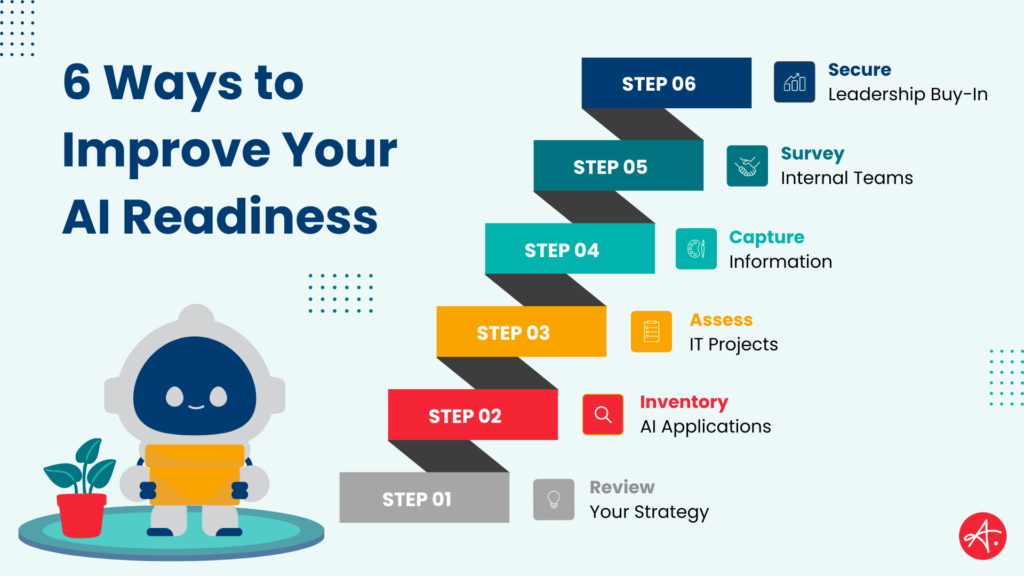
- Review your business strategy and business plan. Does it reflect the current state of your business and the opportunities you want to pursue? If your plan is stale, you should update these items first before you go any farther.
- Assign someone to inventory all of the AI applications which may have made their way into your business. Even if you haven’t consciously licensed them, they may have come in as add-ons to other applications, like document processors such as Microsoft Word, browsers, and apps like Zoom.
- Take a complete inventory of all your IT projects and determine whether you have the capacity, people, and finances to start an AI project at the current time. Your existing initiatives may need prioritized focus first.
- Find a server location accessible to your staff to start capturing relevant business information and content which you may need in the future to fuel AI initiatives.
- Ask your sales and customer support teams whether customers have asked about your plans for AI, or if you are at risk of losing business to competitors who are adding value through AI solutions. Survey internal teams to understand where employees have identified opportunities for AI innovation.
- Assign a business leader and a technology leader to co-lead your initiatives—at least to get started.
AI will inevitably have an impact on your business. Now is the time to proactively take stock of your organizational readiness.
Chapter Three: 7 criteria to use when building an AI readiness assessment for your business
You may think you are already late to the AI adoption game. However, it’s important to assess your business’ readiness to use AI instead of blindly hopping on the bandwagon. The tech firms supplying AI tools are bullish about their offerings, but there are still many unanswered questions:
- Just how polished and market-ready are they?
- How are they ensuring that their tools meet data governance regulations for data privacy?
- Are the AI tools safe, secure, and scalable?
- Are they built with a commercial strength tech architecture?
Your business will benefit from a scorecard exercise to make your own assessments of each AI tool so you are making the best selection possible in a rapidly changing market. Having your criteria developed upfront enables you to make impartial comparisons.
Let’s take a look at what criteria you might include on your AI assessment. We can look at historical technology adoption for guidance.
A brief history of technology adoption
AI tools may be entering your business both on purpose and through benign technology asset neglect. When you look back at the adoption of the Internet in small- and medium-sized businesses, renegade departments (often marketing or product groups) moved faster than corporate IT organizations. You may not have even been aware of these maverick efforts until they showed up in the marketplace!
An example from my career
One major bank I worked for hired expensive consultants to build an Internet architecture for the organization. They had a one-year charter, during which no one was supposed to start an Internet project. As a business leader charged with payment innovation, I felt the one year waiting period was too constraining, and with a vice chairman’s support, my team delivered an Internet payment solution in the same window that the bank’s technical architects were deciding what technologies were to be allowed. With a vice chairman’s knowledge, we built the business on the Microsoft Internet tech stack–a real heresy in the banking world at the time. The bank now processes billions of payments transaction value on that same platform over twenty years later!
Another business unit in that bank started offering mobile payments without “permission.” Quickly, the convenience of mobile outplaced the bank’s support capabilities, and the mobile app had to be withdrawn from the market until the bank’s infrastructure could support it.
The above examples from my career do a great job of illustrating the delicate balance between supporting a strong technology architecture and addressing urgent business needs to stay competitive in the market.
How to design an AI readiness assessment for your business
Assessing AI tool readiness for commercial deployment is a challenge for many businesses. With the rapid pace of new AI tool releases means many tools will be here today and gone tomorrow. Here are two quotes from a recent article summarizing the 2024 Milken Institute Global Conference that reinforce this point well:
“I think I will look back in a year and realize how laughably bad [AI systems] were.”
Brad Lightcap, Open AI COO, on the technological advancement still to come
“99% of the companies are going to be awful, overvalued, and in many cases, fail. Everybody, including myself, we’re all investing in the 1% and we’re probably wrong.”
Elad Gil, entrepreneur, operating executive, and investor, on the future of AI startups in the market
How confident can you be with AI technology when major industry players are expressing these concerns about their own companies or investments? Moreso, what should you do knowing that industry insiders and major investors have their own skepticisms about AI today?
A foundational principle in constructing your AI readiness assessment
There are some good (and free) background resources available from companies like Info-Tech Research Group, which curates an AI Research Center, to help leaders understand how to think about AI and a business’ technology platform(s). Data scientists and engineers at Info-Tech focus on integrating AI into the operational fabric of IT. They are bullish on how to maximize value from AI, stating:
“As organizations seek to harness the full potential of AI to achieve greater efficiency, increased revenue, and enhanced customer experience, long-term success hinges on integrating AI into the operational value of IT.”
In other words, start by considering AI as part of your tech platform, not as a one-off technology. This is a clear principle statement which will help you bring the same level of management, processes, and expected results that you expect from other tech investments.
What criteria belong in your AI readiness assessment?
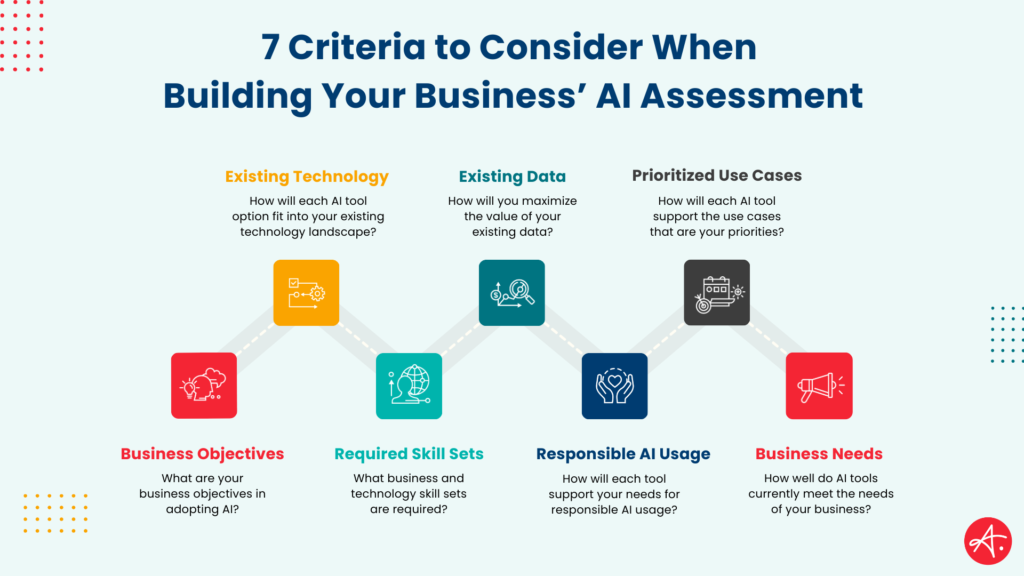
As you dive into building your business’ AI readiness assessment, here are 7 key questions to consider.
- What are your business objectives in adopting AI?
Following the “business first, AI second” approach, the first item on your AI readiness assessment should be a statement of objectives.
- How will each AI tool option fit into your existing technology landscape?
For example, are you a Microsoft or Google shop? Many AI tools are delivered already bundled and integrated into business applications, like Word, PowerPoint or the Google suite. It’s helpful to place value on vendor integration because that puts the onus on the vendor to continue to ensure the AI tools work seamlessly with their applications. This means you can focus your time on using them most effectively.
- What business and technology skill sets are required to maximize the implementation of AI tools and realize business value from them?
AI tools are not nearly as challenging to bring in-house as relevant human talent is. Your answer to this question can also be dependent on your existing technology landscape.
- How will you maximize the value of your existing data?
AI is dependent not just on accessible industry data, but more importantly, on your data. How will each AI tool leverage your data and its data quality? You cannot easily recreate this asset, you need to leverage it.
- How will each AI tool support your needs for responsible AI usage?
The challenges with AI data governance include acceptable use policies and controls over data collection, privacy, and distribution. Which AI vendors best match your controls and concerns?
- How will each AI tool support the use cases that are your priorities?
This criteria encourages you to establish first what you want to accomplish, and then second, which AI tool best fits your needs. With the rapid evolution of AI tools, this may be a challenge for your assessment, but you need to start somewhere. You should establish a plan to review the performance of the AI tools you bring in on a regular basis. Quarterly would be a good cadence. There is a good likelihood that the tools you test today will not be the ones you use longer term. Even the leaders of AI forms themselves would agree with this. Think about your relationship with AI tools as dating, not getting married.
- How well do AI tools currently meet the needs of your business?
Can the AI vendors supply you with case studies where they have delivered AI tools which have been proven to solve the same needs you have? When you ask for case studies, make sure they offer quantitative benefits and outcomes. This goes beyond feel-good stories. It’s about providing hard evidence of success.
Chapter Four: 6 recommendations to implement change management in your organization
Early research into the adoption and acceptance of AI tools in businesses only scratches the surface of opinions held by employees. Today’s workforce is highly polarized in their view of AI, which often spans one of two directions:
- Fear that AI will completely replace people and their jobs
- Excitement around how AI will improve and streamline job functions
These completely opposite views will make collaboration and acceptance a challenge for business leaders. What if the correct answer on the impact of AI is: “It depends on your position.”?
There are also many opinions that fall somewhere between these two views; like workers who welcome the productivity of AI in their role. I learned years ago that concepts like growth and productivity are viewed very differently by staff than they are by management. Most executives think growth is good while many staff think that growth is good as long as it doesn’t double their workload.
Following historical precedents for how workforces have embraced new tools can be helpful. Not everyone thought personal computers were going to be revolutionary game changers—early market forecasts by companies like IBM in the 1980s had very low unit forecasts. Part of the constraint in growth was a narrow vision for what PCs could do and how they could be used.
We are in that same position today. Lots of ideas and applications for AI are being proposed, but few have been validated in creating actual value.
Establishing a baseline for change management
You can read about staff reactions to AI as new third party research emerges, but this is one area where I would caution that what is most important is your deep understanding of where your staff stands.
A path to building internal support for AI can be adopted from any good change management approach, ideally a model that focuses on making the most of change, together with large doses of reality and practical guidance. One suggested framework is from a book titled Managing Transitions-Making the Most of Change, authored by William Bridges. Bridges is upfront when he states:
“We’re not saying that transition management is easy—just that you can do it. Which is a good thing, since you don’t really have a choice. You need to chart your way through chaos.”
It’s important to honestly acknowledge the challenges involved, but also the application of proven processes. And when it comes to AI, what choices do you have? Your goal for AI tools is to get the highest value and return from the lowest initial investments and create the least internal chaos along the way, which would be one of the worst outcomes I could imagine.
6 recommendations to implement change management in your organization
Here are some of the principles from the Managing Transitions book, summarized into 6 recommendations:
- Treat your AI initiatives as a new beginning. They may ultimately represent the end of something but focus on the positives and the release of corporate energy in a new direction.
- While understanding that people need to be able to understand the desired outcome, the first task of transition management is to convince people to “leave home”. Bridges claims that the single reason most organizational changes fail is that no one has thought about endings and their impact on people.
- Take an approach which demonstrates your willingness to professionally educate your staff on AI, no matter what department they are in. Learn together, discuss openly, share information and make sure everyone feels that they have the latest information.
- Reinforce the nascent adoption of AI and discuss the business priority of getting AI hands-on experience through several small and controlled pilot projects. Assign small teams to each AI pilot project and have them take ownership for implementation, reporting, and progress monitoring.
- Engage your staff by asking them to contribute what they have learned to your discussions:
- What have you experienced?
- Are customers asking for AI-enabled applications?
- Where are your competitors on their AI adoption cycle?
- What internal business processes would they put on a list for future AI enablement?
- Proactively lead your staff through the “neutral zone” where you have not fully committed to AI, nor have you fully left behind all of your old ways of working. The neutral zone has to allow for successes and failures but cannot truncate the work, discussion, and ambiguity needed to find innovative solutions. Rushing to an answer—any answer—without allowing for this critical learning period may make you feel like you have resolved staff anxieties but may also result in some of the best ideas being discarded.
The Leader’s Role in Change Management
I worked for an executive who had the challenging opportunity of finding a home outside our current business for 5 product groups who were declared “not mainline” any longer. He kept everyone very engaged as each product line was packaged, sold and removed from the portfolio. I asked how he did this so successfully, and his answer started his simple philosophy: “I treated everyone the same, since I recognized that I was impacted as well.”
Your ability to treat AI tools transformationally will be based more on your success of getting your staff involved than it will be on selecting the right AI tool supplier, or the best internal applications to deploy. AI is about trial and error, and being an inclusive, transparent leader will help ensure your success. After all, it’s about the people, people!

Conclusion
Adopting new technology like generative AI and other AI processes into your business can be challenging, but with the right marketing foundation and strategy, it can have a measurable impact. Unsure how to get started? Building a marketing foundation doesn’t necessarily require full-time marketing leadership.
Authentic Fractional CMOs™ have worked across industries, markets, and business types to help businesses Overcome Random Acts of Marketing® and achieve revenue results. Let’s discuss how Authentic’s model, supported by a strong methodology and mindshare, can help your organization achieve its next-level growth.



